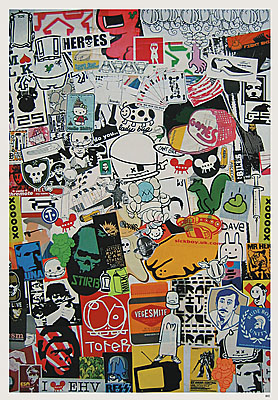| Umělec magazine 2003/3 >> ART OF RESISTENCE 2003 | List of all editions. | ||||||||||||
|
|||||||||||||
ART OF RESISTENCE 2003Umělec magazine 2003/301.03.2003 Tony Ozuna | review | en cs |
|||||||||||||
|
"The art of rebellion comes in all shapes, sizes and colors. It’s not necessarily a new form of social protest, but the format is new. Beyond graffiti, it’s done as elaborate murals, cartoonish characters, deformed corporate-type logos, massive poster campaigns, ubiquitous stencils, stickers, and even strategically placed objects on the street. It’s not done on canvas, or framed, and most importantly, the art of rebellion is not intended for the interiors of galleries or museums.
The art of rebellion is found on the streets. Correction: it’s mostly found on side streets and sidewalks, on the sides of trains and delivery trucks. It is found wherever it doesn’t belong. It is in that spot just around the corner, and there under the bridge, or in that tunnel and on that peeling billboard. Sometimes it’s overtly political, but more often than not, it’s illegible, or nonsensical; it’s often an inside joke, irreverent, in the spirit of Dada. The Art of Rebellion—world of street art 2003, is a fine book compiling street artists from around the globe, but mostly from (and working in) Europe, especially France, Germany, Holland, UK and the USA. Compiled by “c100,” 28-year-old designer Christian Hundertmark of Munich, this full-color, 144-page hardback is a documentation of the best in contemporary street art, and it successfully captures street art in its three most significant contexts: landscape, soundtrack, message. Landscape: taken out of its street context, the art of rebellion loses its oomph. The street itself is the canvas; whether it’s a bustling city center or a desolate industrial zone, the artists carefully choose the background, the landscape to interact with and implant something to contrast zones of blight or rampant, eyesore advertising. The book does not include much from Eastern Europe, with the exception of a 20-year-old Slovak, “CKE” from Rozumberok who has created a stark character combining the letters C K E into the shape of a tuning fork or weird prong. Painted on dreary walls, park benches, massive cement pipes and luminescent advertising panels, in Bratislava, Prague, Warsaw, etc. C K E is one who fits best in wastelands. (http://www.bomb.sk/cpsfd/) Soundtrack: the art of rebellion is fueled by rebellious music; it always has, it always will be. Just as 60s American civil protest movements marched to the soundtrack of Hendrix, James Brown, and John Coltrane, and young Brits in the mid-70s rebelled to the beat of punk and new wave, today’s street artists work the streets late night (with headphones) to the soundtrack of hip hop, hardcore rap, punk, metal, garage rock, electronica, and jazz, or basically anything with raw energy and passion. Appropriately, The Art of Rebellion—world of street art 2003, comes with a mix CD of nu soul, nu jazz, and electro-latino from the Munich label, Compost Records. Compiled by Hundertmark, and mixed by Florian Keller, The Art of Rebellion CD includes tracks by producer-DJs like Minus 8, and Truby Trio, and musicians, like Joseph Malik and others. Compost has been a rebellious force in the recent redefinition of jazz, funk and soul music; its accompaniment to the book is apt. Message: like terrorism, street art now is a global phenomenon; it’s multicultural, transnational, and uncontainable, especially because of its elusiveness. It can be playful or menacing, thus extremely hard to even categorize. A key contributor to the book, Vinnie Ray, of Brooklyn, tries to explain the title Art of Rebellion in the intro: “I keep thinking of France in 1968 when folks were pissed off and took action to the streets. I think that’s what’s happening now globally. Consciously or unconsciously artists are trying to shake up the people that are not cruising galleries. “Trying to wake up the tired workers, whose minds have been filled with fear and consumption. It’s a system of hyper busy lives that can’t be bothered with conditions that are out of their control. I think a fitting statement is… ‘The stakes are too high for politics to be a spectator sport.’ I don’t know who said it, but it’s a good one.” Most likely, Vinnie Ray saw that sprayed on a wall somewhere on the street and not in a gallery. "
01.03.2003
Recommended articles
|
|||||||||||||









Comments
There are currently no comments.Add new comment